FTA (изд-во). Flexography: Principles And Practices. Vol.1-6
Подождите немного. Документ загружается.


122 FLEXOGRAPHY: PRINCIPLES & PRACTICES
ACKNOWLEDGEMENTS
Author/Editor: Patricia A. Cathcart, Polyfibron Technologies, Inc.
Contributors: Paul McGrath, Flexcon
Gary J. Reich, CT Films
Leighton Derr, AET Films
Steve Chilcote, AET Films
Dan Napralla, REXAM Metallizing
Don Voas, International Paper
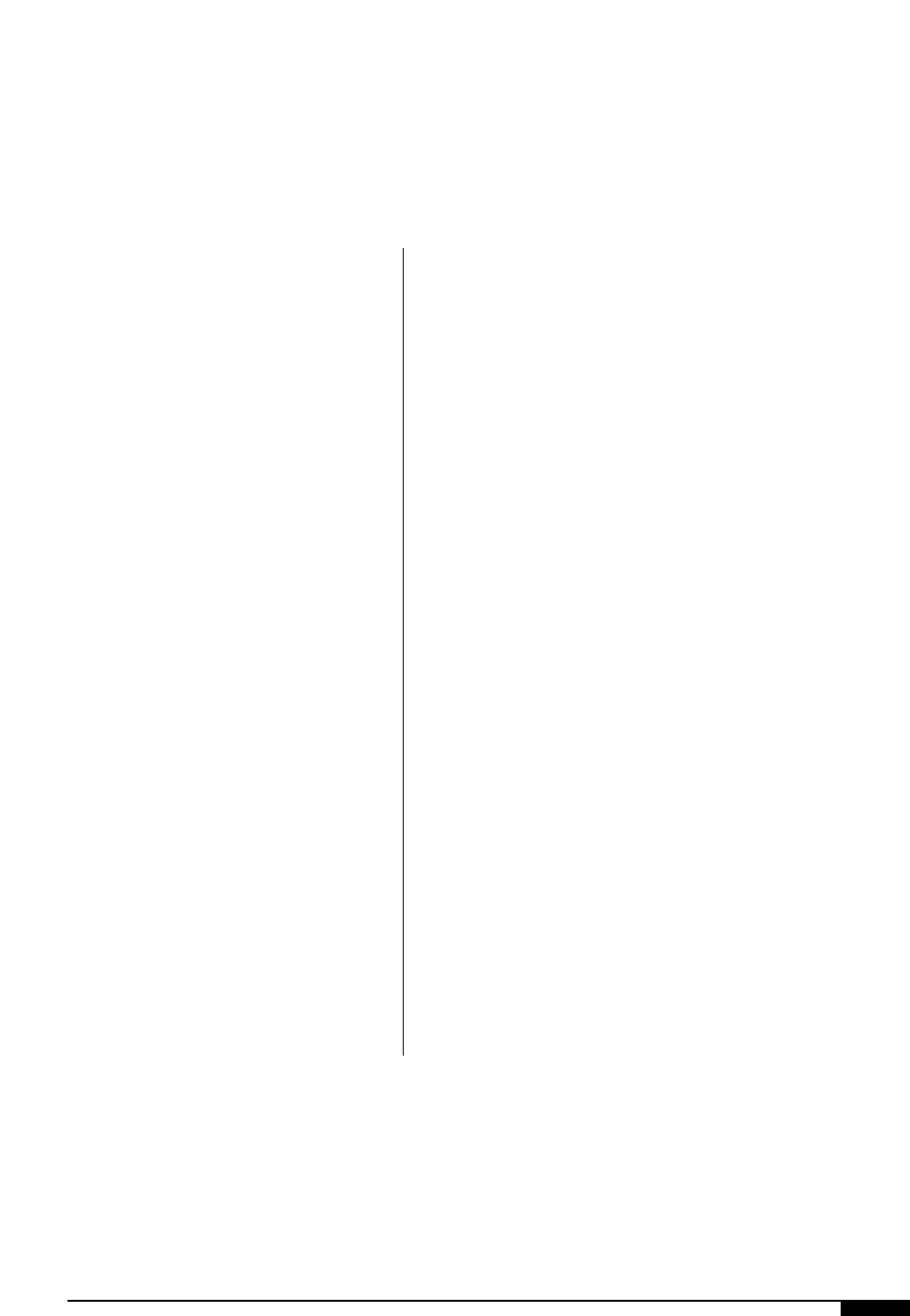
SUBSTRATES 123
A
substrate is a material defined
by Webster’s New World Dic-
tionary as “a medium or a sub-
stance which supports anoth-
er; a foundation.” In printing,
the substrate supports the ink
film that carries the message needed to
describe the internal contents of a package
or give an advertised message.
Substrates for flexography are varied,
depending on the end use of the material.
There is almost no material that cannot be
printed by the flexo process – from tiny
paper toothpick wrappers, to plastic cover-
ings for mattresses, to metal foils. A major
challenge for the flexographer is under-
standing the substrate material to be printed
because each has special requirements.
Primary topics covered in this volume
include: an explanation of the different sub-
strates; how they differ in their production;
printing characteristics; and guidelines on
how they need to be handled.
New substrates are always being added,
while existing ones are constantly improved
upon in response to new needs. Substrates
are divided into five major groups:
• Paper and Paperboard
• Corrugated
• Laminates
• Foils
• Films
Some classes of substrates have gone
through further development, driven by
changes in market demand, and the advent
of recycling.
The flexographer needs to be aware that
the materials are usually produced to meet
end-use requirements and not necessarily
those of the printing process. This is begin-
ning to change with the demand for higher
print quality. In some cases specialized inks
need to be used, or the current inks have to
be altered. Drying ovens are necessary in
some cases. In the past 10 years, the use of
water-based inks has become prevalent on
paper substrates and even on some plastic
films.
The objective of this chapter is to educate
the printer about the properties of various
substrates. Information presented is de-
signed to make it possible and convenient
for the printer to ensure that each material
meets its proper specification before, as well
as after, it is printed.
Common materials are listed under the
five main groups. A brief description of the
material manufacturing process is offered.
Comments about the characteristics and
problems associated with the substrate that
are frequently encountered by the flexogra-
pher are provided.
Introduction
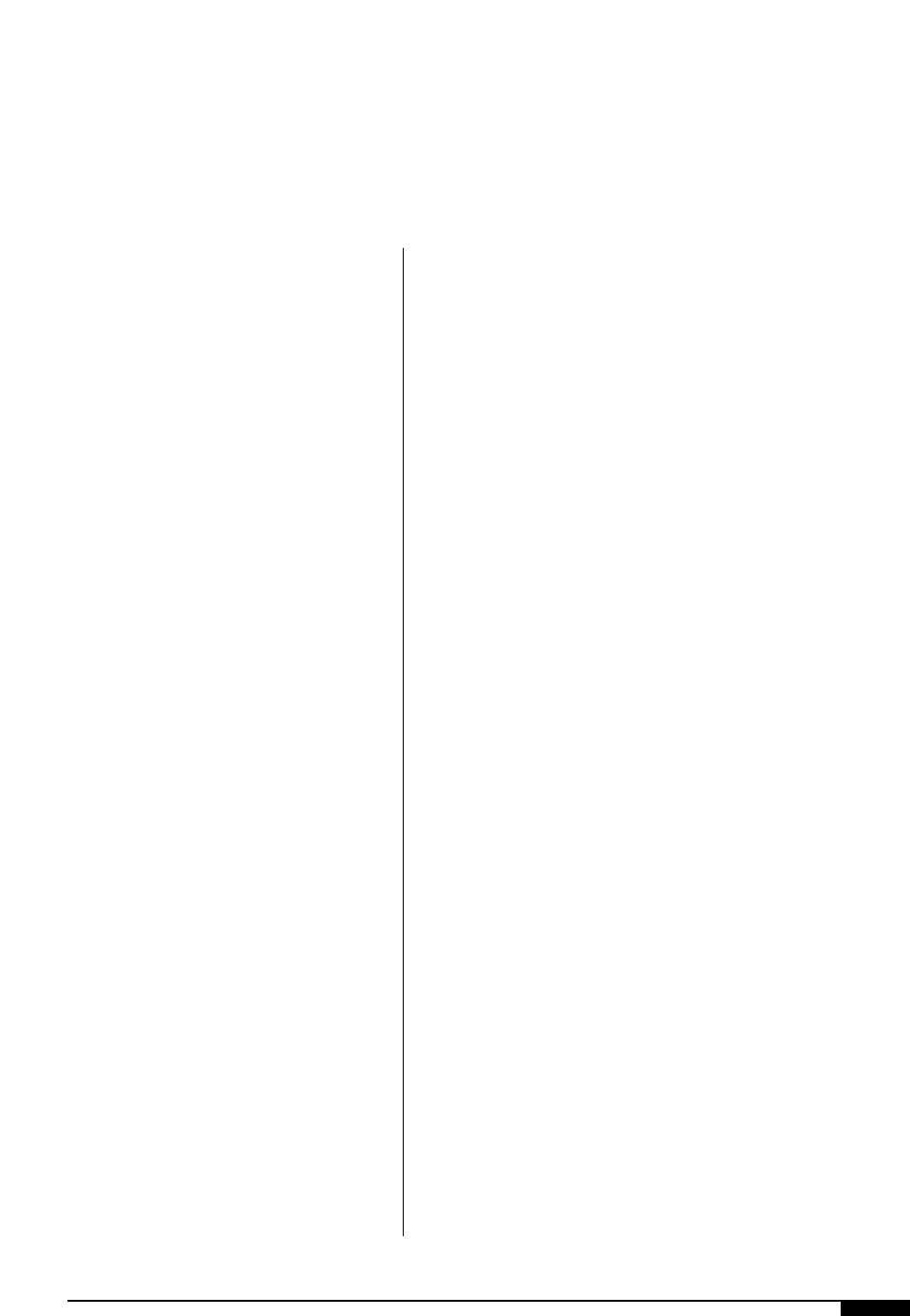
P
aper is one of the oldest sub-
strates used for printing and has
gone through many changes as
materials and environmental
concerns have influenced pro-
duction. It is believed that man
first invented paper about 200 B.C., but the
earliest known record attributes the develop-
ment and production to the Chinese, begin-
ning early in the second century A.D. This
paper was made using bark, hemp and rags
as the chief ingredients.
The Chinese continued to refine their
paper-making skills and developed starch siz-
ing in the second half of the eighth century.
Starch aids in keeping the fibers bonded
together and holds the ink out at the surface
to prevent blurring the printed image. The
development of paper with sizing was con-
tinued in the Middle East and later in Spain
and in Sicily. Most paper was made by hand
until the 18th century when the Fourdrinier
brothers developed the first practical paper
machine.
The Fourdrinier machine formed a contin-
uous strip of paper instead of the single-sheet
production of the hand-made paper. This
innovation facilitated the further develop-
ment of printing presses. A second milestone
was marked though the use of wood pulp for
paper production. Prior to wood pulp, the
chief ingredient in papermaking was rags.
The new plentiful and renewable ingredient
supported increased large-scale production
to meet the rapidly growing demands for
printed material.
As more people were educated, the
demand for knowledge grew. The rising read-
ership of newspapers and books resulted in
other new developments: advertising and
mass distribution. These in turn necessitated
new methods for wrapping and packaging
merchandise for delivery to consumers.
MANUFACTURING PROCESS
Paper can account for anywhere from 40%
to 60% of the cost of a final printed job, so it
is important to understand the manufacturing
process. The original Fourdrinier invention is
still in use today on most paper machines.
Every piece of equipment can be broken
down into three sections: the wet-end, the
press section and the drying section.
From the wet end, or headbox, a dilute slur-
ry of fiber and additives consisting of about
99% water is deposited onto an endless mov-
ing wire where most of the water is drained
away. Further water is removed by perforated
suction boxes beneath the wire.
The fragile wet web is transferred to the
press section where a supporting wool or
synthetic fabric felt passes the paper through
wringers and suction rolls to the drying sec-
tion. There, heated cylinders reduce mois-
ture to the desired finished level. Paper
caliper and surface smoothness are estab-
lished by passing the web between a calen-
der stack of steel rolls. Finally, the paper is
wound onto a huge reel at the dry end of the
paper machine.
Additional steps might include adding pig-
mented coating(s) to one or both sides of the
web, rewinding to remove defects, slitting the
master reel to the desired roll width and
diameter, or other post-production enhance-
ments. Figure
8^
shows the wet end of the
paper machine.
SUBSTRATES 125
Paper and Paperboard
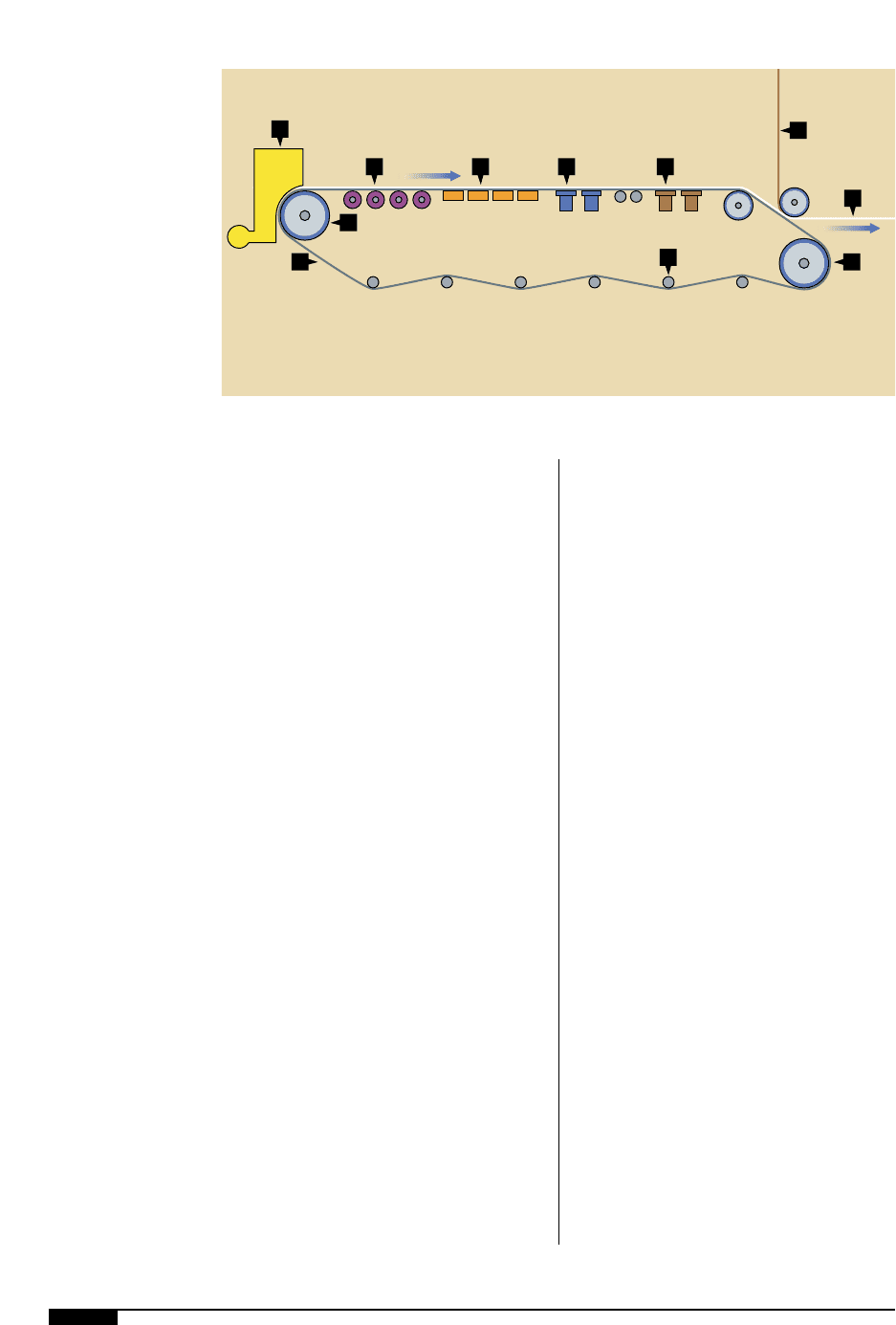
8^
At the wet end a paper
manufacturing process,
a dilute slurry of fiber
and additives consisting
mostly of water is
deposited onto an
endless moving wire
where most of the water
will be drained away.
126 FLEXOGRAPHY: PRINCIPLES & PRACTICES
The ideal printing paper would be one that
has identical characteristics on both sides.
Paper traditionally has had a characteristic
two-sidedness, or top side of the sheet,
known as the felt side, and the bottom of the
sheet, or the wire side. The difference
between sides could be determined visually
by means of the screen mark left on the wire
or bottom side during sheet forming.
Newer paper machines with twin wires
make the two-sidedness less apparent. The
two-sidedness is most apparent in the differ-
ence in ink receptivity due to the inconsis-
tencies in the concentration of “fines” or
small fibers and fillers. The felt side is more
closed because the fillers are concentrated
on the top of the sheet, while the wire or bot-
tom of the sheet is more open due to the
drainage of water through the fibers forming
on the wire. The use of retention aids and
newer machines have helped to eliminate
some of the top-to-bottom differences in
mechanically produced paper.
Production of Wood Pulp
There are four main types of pulping meth-
ods: mechanical, chemical, semichemical
and thermomechanical.
In the mechanical or groundwood method,
logs are pressed against huge revolving
grindstones to defiber the wood, and the
pulp is flushed from the stones with streams
of water. This pulp is made up of short, stiff
fibers which have little strength properties.
Paper made from this pulp is the least expen-
sive because none of the lignin, resins or
impurities have been removed and as a result
the paper will darken very readily. Newsprint
is a common example of a high groundwood
paper but even this product needs the addi-
tion of longer, chemically treated fibers to
provide sufficient strength for processing in
high-speed printing presses and folders.
Chemical processes for producing wood
pulp provide papers that are stronger and
more impurity free than the groundwood
process. Continuous batch digesters produce
papers that are more permanent. There are
two types of chemical pulping, sulfate (or
kraft) and sulfite. The sulfate process yields a
wider variety of products which are stronger
than those from the sulfite process. Hence,
the sulfate process is more commonly used.
Semichemical pulps are sometimes used in
varying proportions with chemical fibers to
provide bulk or other desirable combinations
at the lowest cost. All chemically separated
fibers are longer, stronger and free from the
resinous contaminates in the wood itself.
Papers with no groundwood fibers are
known as “free sheets” (groundwood free).
Free sheets are used for business papers,
D E F G
K
I
A
C
H
J
B
A Headbox
B Wire
C Breast Roll
D Tube Rolls
E Foils
F Wet Suction Boxes
G Dry Suction Boxes
H Felt
I Paper
J Couch Roll
K Tension Rolls
8^
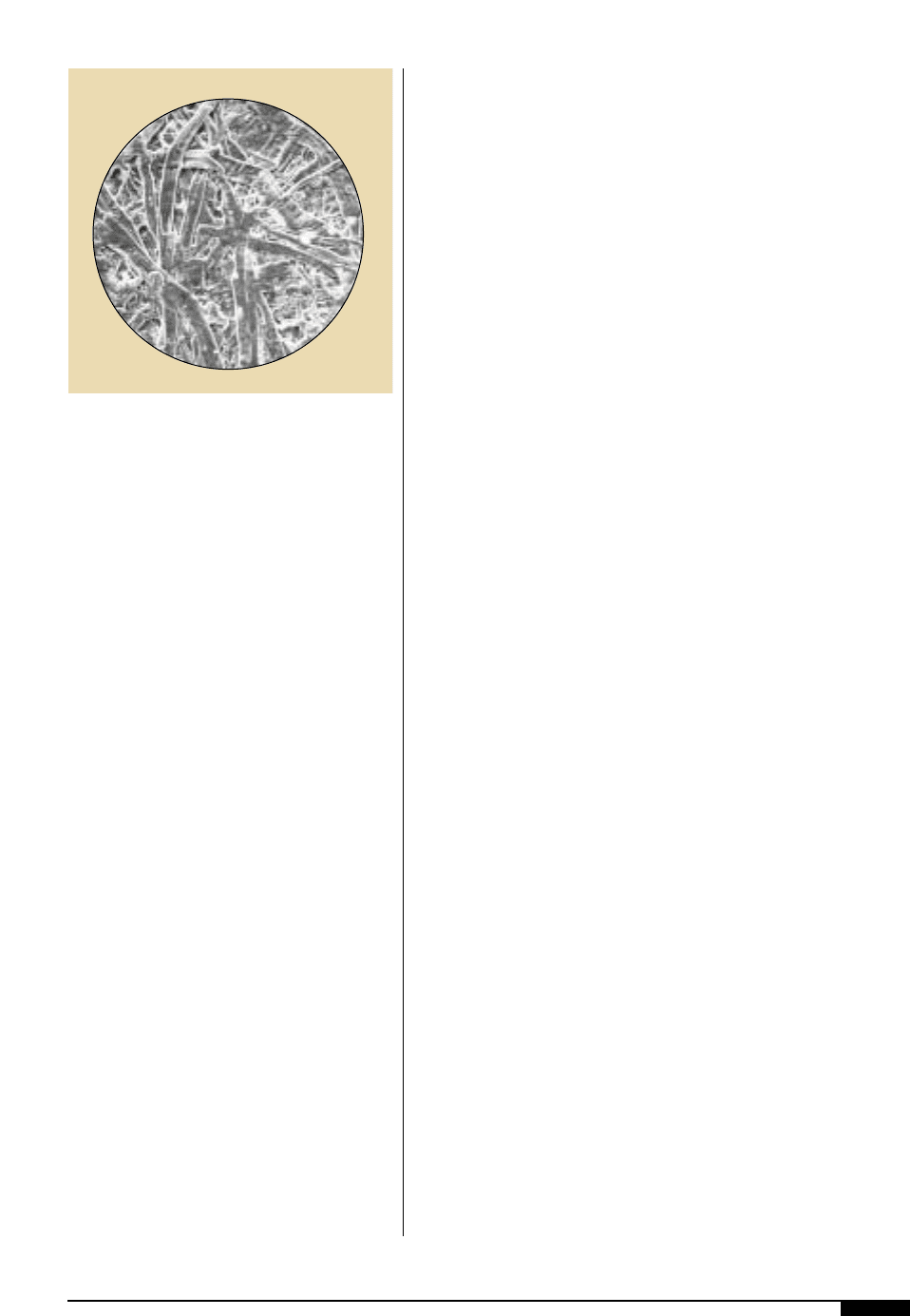
forms, envelopes and book grades.
The newest types of pulping are thermo-
mechanical (TMP) and bleached chemi-ther-
momechanical (BCTMP). Mechanical pulp-
ing causes damage to the fibers that results in
fiber bundles and requires the addition of
chemical pulp to provide strength. Thermo-
mechanical pulping produces groundwood
with a better yield and higher strength. This
pulp can be used for newsprint without the
addition of chemical pulp.
After pulping, the fibers are bleached with
a variety of chemicals such as chlorine, chlo-
rine dioxide or sodium hypochlorite. The lat-
est bleaching technology involves the use of
oxygen with the chlorine. Bleaching re-
moves color caused by lignin and other
impurities that can affect the quality of the
paper. Bleaching does reduce the strength of
the fibers. The last step is refining or beating,
which frays the fibers and improves their
ability to bind to one another when a sheet is
formed.
Paper Fibers
Paper can be described as a mat made
from a combination of hardwood and soft-
wood fibers, the blend of which is deter-
mined by the desired finished product
requirements (Figure
8&
). Softwood fibers
are longer and add strength to the paper
while the shorter hardwood fibers fill in the
voids between the long fibers and give
greater smoothness. Depending on whether
strength and economy or appearance and
printability are the criteria, different combi-
nations of fiber blends will be used.
Colored papers are produced by the addi-
tion of dyes to the slurry in the stock prepa-
ration section or headbox (wet end of the
paper machine) prior to the wire. These
papers are expensive and must be made in
large quantities due to the expense of paper
machine changeovers.
Today, due to warehousing costs, the con-
cept of “just-in-time” inventory is popular.
White paper can be inventoried and, as need-
ed, can be tinted on the felt and/or wire side
using flexography in line to produce the
desired quantity of colored paper or board.
Recycled Fiber/Paper
The use of wood fiber made paper produc-
tion inexpensive process. A side effect of the
paper industry’s enormous production capac-
ity was the solid-waste crisis of the late 1980s.
Paper is the most abundant item in landfills.
Although paper is biodegradable, this process
does not happen quickly. The problem is that
existing landfills are closing every day. It was
estimated in the 1980s that 50% of these land-
fills would close by the year 2000. To resolve
this problem, paper is now recycled.
Recycled paper is manufactured according
to United States Environmental Protection
Agency (EPA) guidelines. The guidelines are
not specific for each paper and can include:
• mill broke, which is paper waste gener-
ated in the paper mill prior to the com-
pletion of the paper making process;
• pre-consumer, which includes convert-
ing waste and trimmings prior to fin-
ished product; and
• post-consumer waste (or paper that has
been printed and de-inked before use).
Paper made from recycled fiber does not
SUBSTRATES 127
8&
The magnified view
of paper shows the mat
combination fo hard-
wood and softwood
fibers. This blend
determines the desired
finished product
requirements.
8&
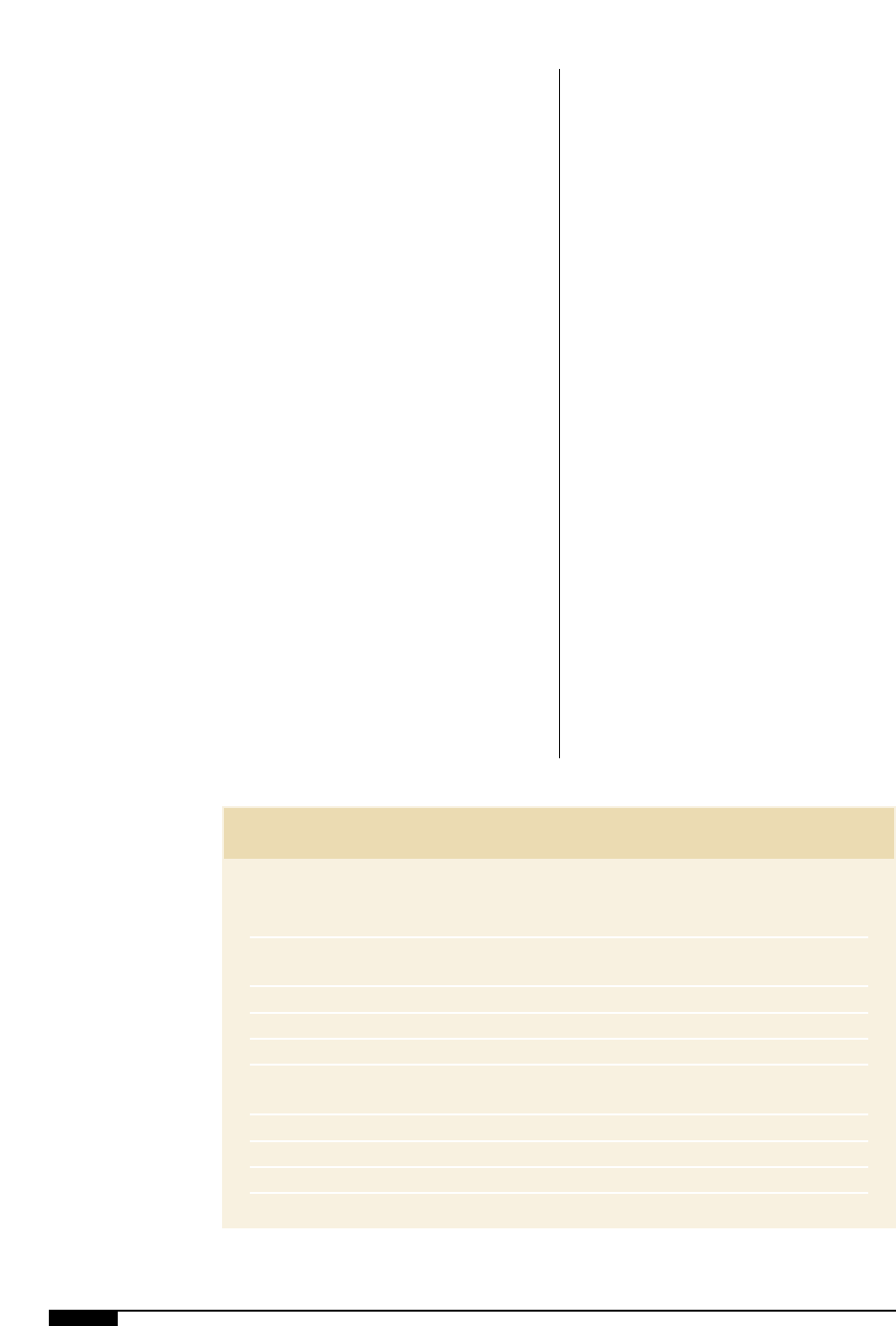
128 FLEXOGRAPHY: PRINCIPLES & PRACTICES
differ very much from that made from virgin
fiber. Some characteristics like formation,
smoothness and opacity can be improved
due to increased pliability of de-inked fibers.
Brightness can suffer, but this can be
improved with the addition of virgin fiber
and optical brighteners. Recycled papers
print comparably to virgin paper with the
added bonus that they tend to curl less and
have greater dimensional stability.
Fillers
Paper contains non-fibrous materials
called fillers. Fillers such as clay, titanium
dioxide or calcium carbonate are added to
modify absorbency, hardness, smoothness,
printability, durability, weight and handling
characteristics of paper. Binders like gum,
methyl cellulose, starch or resins are added
to help hold the fibers together, to increase
stiffness, and to reduce dust and lint. Papers
need fillers to produce higher ink holdout
resulting in less dot gain since, the ink can
be kept on the surface and not be absorbed
into the fiber’s structure.
PAPER PROPERTIES
There are no obvious distinctions in the
definition between paper and paperboard.
The major difference lies in the caliper.
Generally, papers are either coarse or fine.
Coarse are the kraft papers, and fine are the
bleached, smoother papers.
Paper is classified based on its end use
and the term used for this description is
called grade. Each grade is formulated dif-
ferently so its characteristics are appropri-
ate for the ink that will be applied and the
equipment on which it will be run. Paper per-
forms best when used for its intended pur-
pose, but some papers are considered dual
purpose. A good paper is one that prints and
converts successfully. Finished paper prop-
erties can be broken down into several clas-
sifications:
• structural or mechanical;
• surface finish and appearance; and
• chemical.
These properties apply to both paper and
paperboard. However, the method for their
determination may differ. The following is
meant as a brief definition and does not nec-
Table 18
BASIC SIZE REAM AREA BASIS WEIGHT GRAMMAGE TO
PAPER (IN) (FT
2
) TO GRAMMAGE BASIS WEIGHT
■ Linerboard 1,000 4.883 0.205
■ Writing, Printing,
Computer, Bond 17 x 22 1299 3.760 0.266
■ Cover 20 x 26 1806 2.704 0.370
■ Cardboard 22 x 28 2139 2.283 0.438
■ Bristol, Tag 22.5 x 28.5 2227 2.193 0.456
■ Paperboard, News,
Wrapping, Bag, Tissue 24 x 36 3000 1.628 0.614
■ Book, Text, Offset 25 x 38 3299 1.480 0.676
■ Index
■ Newsboard 26 x 38 3431 1.423 0.703
Note: All values except paperboard based on a 500-sheet ream.
REAM WEIGHT CONVERSION FACTORS
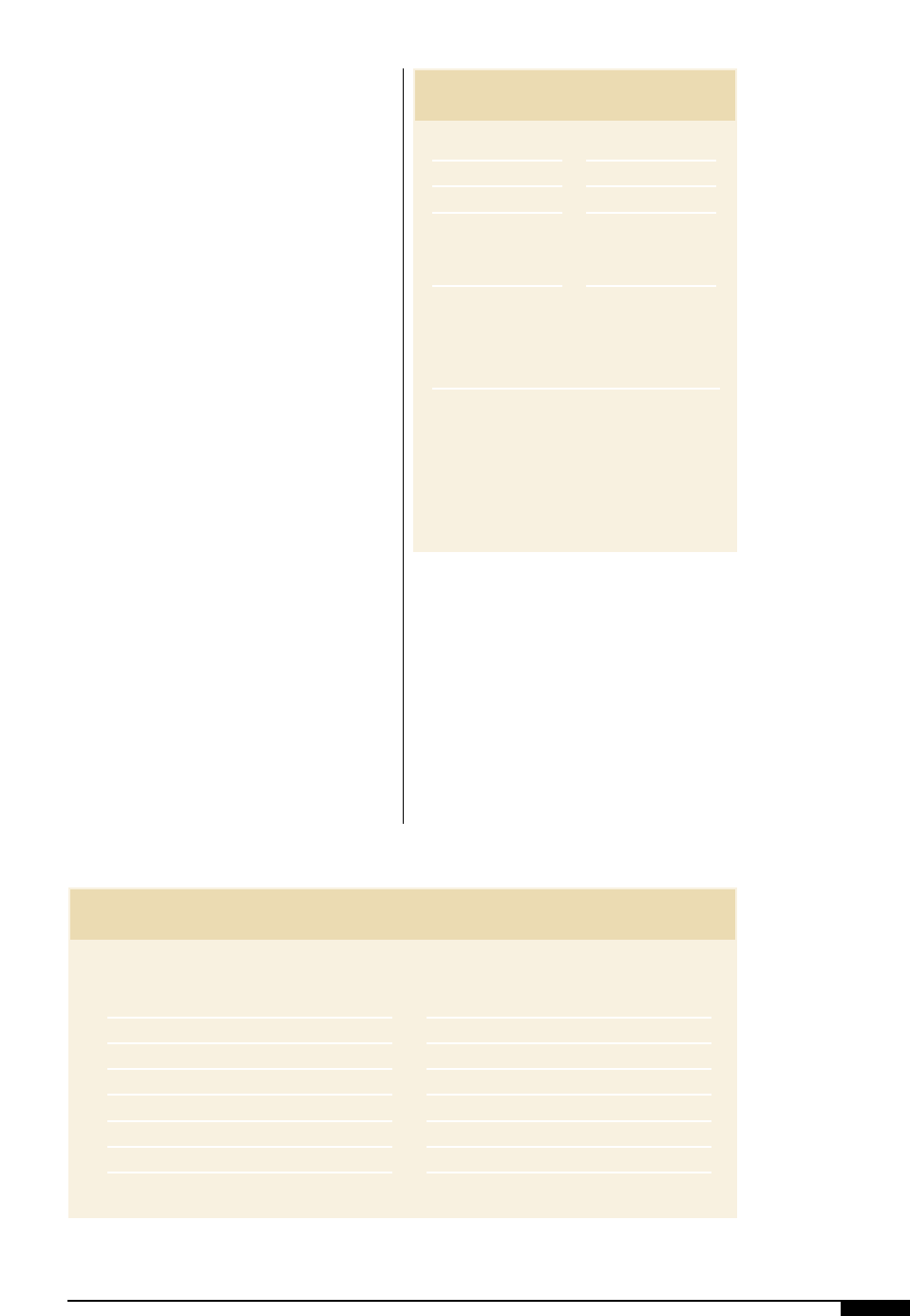
essarily describe the test method or go into
great detail of the method.
See Appendix A for the listing of TAPPI
(Technical Association of the Pulp and
Paper Industry) test methods according to
substrate type: paper, paperboard and corru-
gated board.
Structural or
Mechanical Properties
Basis Weight. Basis weight is the weight in
pounds of a ream (usually 500 sheets) of
paper at a given sheet size (usually the basic
size for a given grade). These 500 sheets also
represent an area of paper. For example, 500
sheets of 25" x 38" is equal to 3,300 square
feet of paper. Therefore, the basis weight can
be converted to a weight per unit area or
pounds per square foot. Today, due to the
International Organization for Standard-
ization (ISO) requirements, the recommend-
ed expression of basis weight is in grammage
(metric unit of weight). In metric measure,
paper size or area is expressed in square
meters and the weight per unit area is
expressed as grams per square meter (g/m
2
).
Table 18 lists some common ream sizes and
their conversion factors to grammage or met-
ric units. For example, a 17" x 22", 20# bond
paper is equivalent to 75.2 g/m
2
(20 x 3.760).
Table 19 lists some useful conversion values
and Table 20 shows the metric “A” and “B”
sizes.
Bulk. Bulk is another way of describing the
thickness of a sheet. Bulk is also expressed
as the number of pages (two pages per sheet
or the number of sheets multiplied by two)
needed to reach one inch of thickness. It is
an important factor where a volume of paper
SUBSTRATES 129
Table 19
KEY:
lb = pound ft = foot
g = gram in = inch
m = meter in
2
= square inches
cm = centimeter ft
2
= square feet
m
2
= square meter
cm
2
= square centimeters
1 lb = 453.6 g
1 ft. = 12 in
1 ft
2
= 144 in
2
1 m = 100 cm
= 39.27 in
= 3.281 ft
1 m
2
= 10,000 cm
2
= 10.76 ft
2
= 1,550 in
2
1 gm= 0.002205 lb
1 in = 0.08333 ft
1 in
2
= 0.006944 ft
2
1 cm= 0.1 m
1 in = 0.0254 m
1 ft = 0.3048 m
1 cm
2
= 0.0001 m
2
1 ft
2
= 0.0929 m
2
1 in
2
= 0.00645 m
2
CONVERSION VALUES
Table 20
LENGTH WIDTH LENGTH WIDTH
“A” SIZE (MM) (IN)
A0 1,189 841 46.819 33.106
A1 841 595 33.106 23.410
A2 595 420 23.410 16.553
A3 420 297 16.553 11.705
A4 297 210 11.705 8.277
A5 210 149 8.277 5.852
A6 149 105 5.852 4.138
A7 105 74 4.138 2.926
LENGTH WIDTH LENGTH WIDTH
“B” SIZE (MM) (IN)
B0 1,414 1,000 55.669 39.364
B1 1,000 707 39.364 27.835
B2 707 500 27.835 19.682
B3 500 354 19.682 13.917
B4 354 250 13.917 9.841
B5 250 177 9.841 6.959
B6 177 125 6.959 4.921
B7 125 88 4.921 3.479
METRIC “A” AND “B” PAPER SIZES
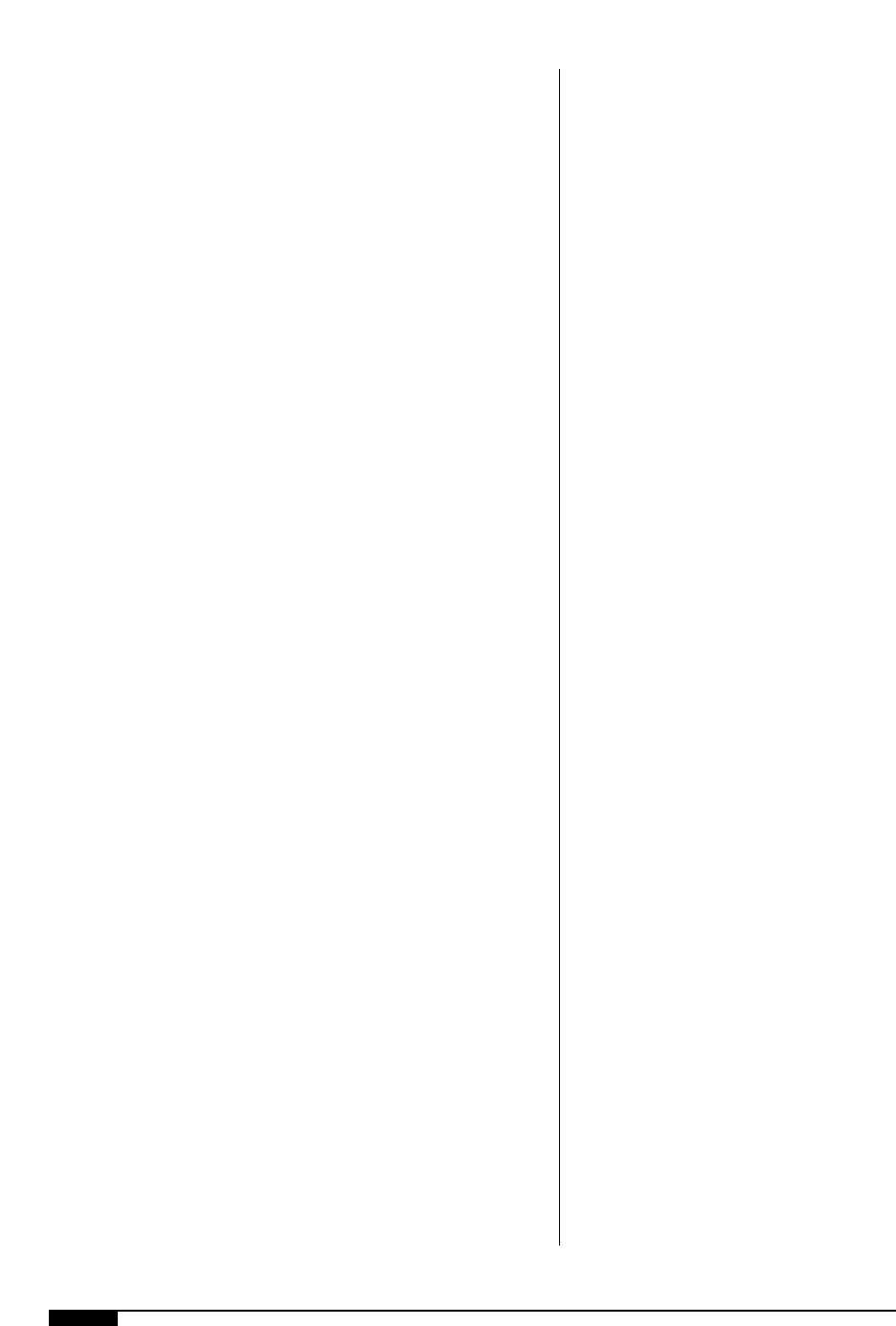
130 FLEXOGRAPHY: PRINCIPLES & PRACTICES
will be converted into a product that must fit
into a specified container for shipping. This
is important for books, envelopes and busi-
ness forms.
Burst. Burst is a measure of a combination of
properties, like tensile and stretch, up to the
point of rupture. Burst differs from tensile
strength in that the force used for the failure
is in a circular direction, while tensile is in
one direction only. Packaging paper must
meet minimum bursting-strength require-
ments.
Caliper. Caliper is a measurement of the thick-
ness of a single sheet of paper, paperboard or
combined board measured with a micrometer
under a static load for a minimum specified
time. The unit of measurement is thousandths
of an inch, or mils. Caliper is important
because wide variations can cause the final
print impression to be uneven. Caliper and
smoothness are inversely related. Higher
caliper papers tend to be rougher while lower
calipers tend to be smoother. Caliper affects
both stiffness and bulk. Heavier-weight papers
and paperboard have calipers expressed in
points (each point is equal to 0.001".)
Curl. Curl is non-flat paper caused by changes
in moisture content or physical stress and
may take many forms. Due to changing rela-
tive humidity, and ultimately paper moisture,
stresses in the paper may become unbalanced
and a curl will develop. As a general rule,
fibers expand (contract) about three times
more in diameter than in length with
increased (decreased) moisture. A paper’s
wire side, with a higher concentration of fiber,
is more reactive to moisture changes than the
filler-rich felt side. Reel curl may occur near a
roll core with paper wound too tightly and
take on a permanent set in this position.
Density. Density is the value obtained by
dividing basis weight, expressed as mass per
unit area, by the caliper. Paper that is com-
pact and tightly formed will have a higher
density value.
Dimensional Stability. Dimensional stability is
the ability of a paper to hold its original size
or constant dimension in all directions when
exposed to physical stress or variable mois-
ture. This is a very important property espe-
cially where unit-print stations are used and
more moisture is added by water-based ink
at each unit. Papers with poor dimensional
stability will not hold color-to-color register
and may result in a poor, blurred print.
Folding Endurance. Folding endurance is a
paper’s ability to withstand repeated flexing
or folding and bending. The test is usually
run in both the machine direction and cross-
machine direction of the paper. Government
documents like wills and maps need high
folding endurance. Papers have greater
strength in the cross-machine direction. Pa-
perboard uses a different procedure to mea-
sure this property and the result indicates
the suitability of the paperboard for conver-
sion into folding cartons without a scoreline.
Formation. Formation is the uniformity of the
fiber distribution in the paper. There are a
number of instruments that measure forma-
tion. The higher the number, the more uni-
form the sheet. The values are reported as
flocs (hills) and voids (valleys). Flocs are
densified fiber bundles and voids are areas
with less fiber. Calendering can level out the
surface of the paper but the internal struc-
ture that has the compacted fibers of the
flocs will absorb ink less than the adjacent
voids producing a non-uniform, mottled or
blotchy print. Applying more pressure dur-
ing printing cannot overcome the non-uni-
form or blotchy print since the floc structure
is throughout the sheet and will appear
equally on both sides of the paper. In process
work, the print will appear grainy especially
when working with higher line screens.
Grain Direction. Grain direction is essentially
how the fibers lay or align when they are
deposited on the wire in the papermaking
process. “Grain long” refers to the machine
direction with most of the fibers oriented
somewhat parallel to this direction or the

long edge of a web or sheet. “Grain short”
describes paper or paperboard sheets with
fiber orientation parallel to the shortest
dimension. Grain affects many properties
such as tear, stiffness and fold. Paper expands
when exposed to moisture and most often the
effect will be noticed in the cross-machine or
cross-grain direction. Paper will tear most
readily and is stiffest in the machine direc-
tion. Paper folds most easily parallel to the
grain, but fold strength (number of folds
before tearing) is best across the grain.
Internal Bond. Internal bond is another
method for measuring the failure point of
paper. Unlike burst where the force is equal
in all directions, the internal bond is a mea-
sure along the z-axis. It is an indicator of the
force required to delaminate or split apart
the internal fiber structure when the force is
applied perpendicular to the paper surface.
Porosity. Porosity is a measure of the resis-
tance to air flow through the sheet under pres-
sure. Porosity is an indicator of absorbency
(penetration of oil and water) and hence the
amount of ink that penetrates into the surface.
Porosity also relates to the hardness of the
paper surface.
Stiffness. Stiffness is the flexing resistance of
paper, or its ability to resist an applied bend-
ing force. This property is important in con-
verting operations and requires high values
for sorting and folding applications. High
stiffness is also needed where optical char-
acter readers are used and in envelope man-
ufacturing which requires the transport of
the paper through converting machinery.
Less stiffness is necessary for printing
papers, napkins and paper toweling. Stiffness
increases with basis weight and caliper.
Stretch. Stretch is an indicator of the ability of
the paper to elongate under tension and to
conform to a desired contour. Web tension
must be adequate to form a good roll without
distorting the paper. Web tension on the press
must enable the paper surface to travel at the
same surface speed as the plate and impres-
sion cylinders. Paper stretch is determined
during the test for tensile strength. Paper will
stretch a given amount before failure.
Tear. Tear is simply the resistance of a paper
to tear. It is increased by fiber-refining and is
decreased by most fillers. Good tear proper-
ties are essential for papers like tag, cover,
bond, kraft wrapping and bag. Any paper that
will be subject to repeated handling needs to
have a high tear resistance. Papers are most
resistant to tear in the cross-grain direction.
Tensile Energy Absorption. Tensile energy
absorption, or TEA, is the ability of paper
and board to absorb energy and indicates
durability. Papers like multiwall sack are
subject to repetitive strain and stress.
Tensile Strength. Tensile strength is a mea-
sure of the breaking strength of paper (the
force per unit area required to break a spec-
imen). Strength is determined by the fiber
pulping process and not the thickness.
Tensile strength is indicative of the potential
resistance of a web to break during printing.
Tensile strength is higher in the grain long or
machine direction.
Surface Finish and
Appearance Properties
Brightness. Brightness is a commonly used
industry standard for measurement of blue
(457 nm) light reflectance, usually direction-
al. The standard brightness scale is based on
the reflectance of magnesium oxide, which
is rated as 100% on the brightness scale. The
brightness of a paper will determine the
intensity of printed color. Brightness can be
affected by the addition of optical brighten-
ers that will absorb invisible ultraviolet light
and emit it in the violet to blue region of the
spectrum. Brightness is affected by the
fillers and pigments added during manufac-
ture regardless of the paper color. Lower
brightness is desirable where text is printed
because glare will cause eye strain.
Color. The color of paper, as perceived by the
human eye, is dependent on the light that illu-
SUBSTRATES 131
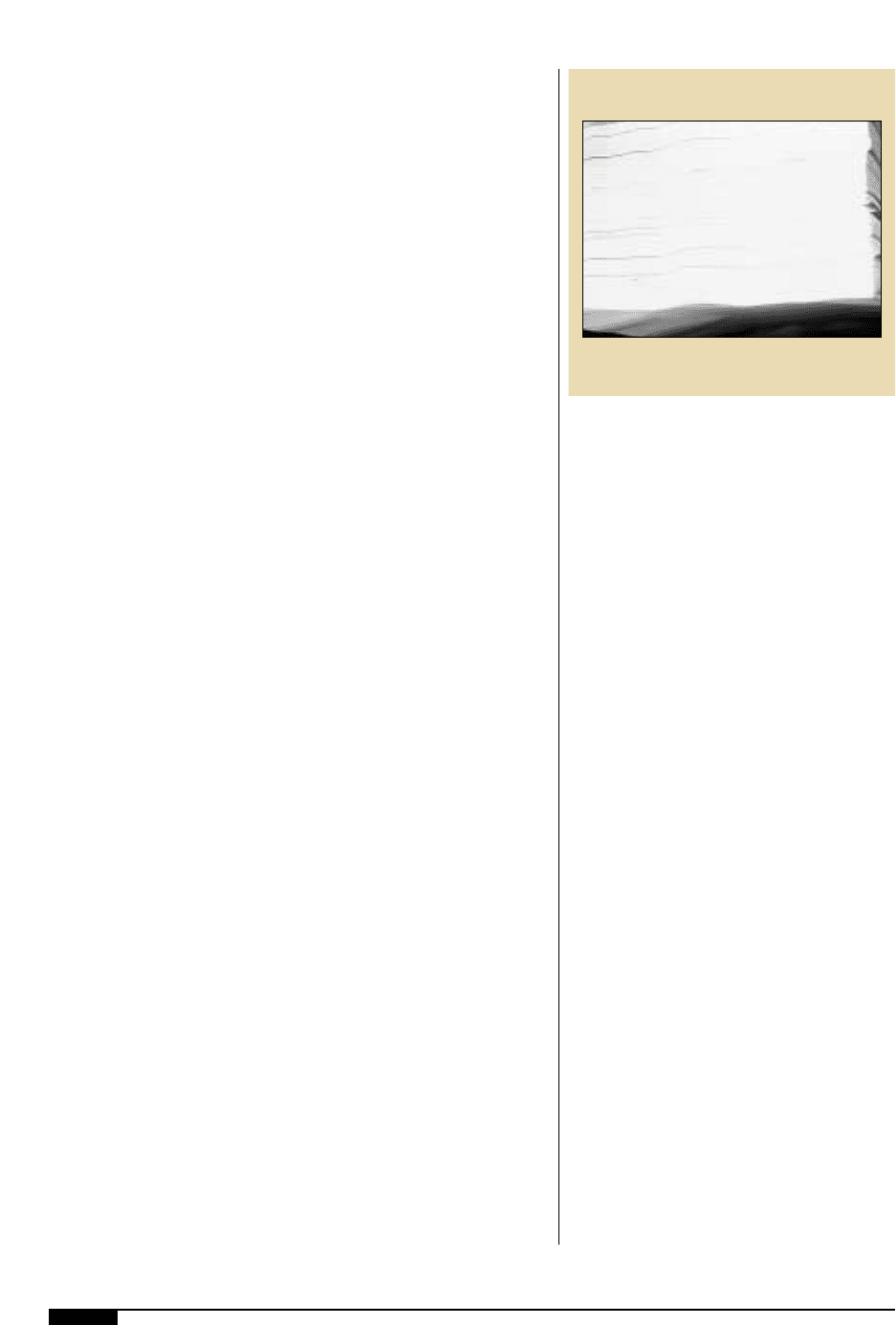
132 FLEXOGRAPHY: PRINCIPLES & PRACTICES
minates the paper. Paper will absorb some
wavelengths and reflect others. If it absorbs
all the wavelengths of white light while reflect-
ing none, then it will be black paper. Most bril-
liant color reproductions are obtained on
papers with high-balanced reflectance.
Friction Resistance. Friction resistance is
sometimes referred to as coefficient of fric-
tion (COF). The coefficient of friction is
expressed in both static and kinetic forms.
The static term is related to the force
required to initiate movement between two
surfaces. The kinetic is the force required to
sustain uniform movement. This is an impor-
tant property for any printing paper and also
for converting operations. Modifiers like
waxes are added to increase the ease with
which papers will move across each other.
Paperboard cartons, file folders and multi-
wall shipping bags must have sufficient skid
resistance to prevent problems during trans-
port. In some cases colloidal silica is added
as an anti-skid treatment.
Gloss. Gloss is the surface quality of the
paper which reflects light like a mirror and
gives it a shiny appearance. It is measured by
an instrument that illuminates a sheet at a
particular angle (usually 75°) and detects
light reflected at the same angle. It is used for
coated and uncoated paper and paperboard.
The smoother a paper surface, the more light
is reflected in this mirror-like manner.
Printed ink gloss is somewhat dependent on
paper gloss. A 20° measurement is preferred
for high gloss, cast coated, lacquered and
highly varnished papers. Neither method is a
measure of image reflecting quality.
Opacity. Opacity is the property of the paper
that obstructs light transmission. Opacity is
influenced by the degree of fiber refining.
Increased refining increases the fiber bond-
ing and decreases the amount of voids in the
paper reducing light transmission. The use
of fillers in the paper also helps to increase
the hiding power or opacity of the paper.
Smoothness. Smoothness is the surface finish
or texture of the paper’s face and is influ-
enced by the fillers, coating, supercalender-
ing and sizing. There are a number of instru-
ments for determining smoothness, so it is
important to understand which method is
being used and reported. In general most of
the instruments are air leak methods and the
lower the number, the smoother the sheet.
Chemical Properties
Fiber Content. Papers are made primarily of
both softwoods (fibers from conifers or pine
trees) and hardwoods (fibers from decidu-
ous trees that lose their leaves). An appro-
priate combination is necessary to obtain
the proper balance between strength and
surface finish for specific paper grades.
Recycled and reclaimed fibers are also used
exclusively or in part for certain grades of
both paper and paperboard.
Moisture. Papers are manufactured to a spec-
ified moisture content. This moisture will
have a direct bearing on how much ink the
paper will absorb during printing. Papers are
made of cellulose fibers that will absorb or
lose moisture very readily. Handling of paper
before printing is critical because paper
picks up ambient moisture from the air. A
very moist sheet will require more ink and
will need many press adjustments to keep
proper registration. Press rooms need to
8*
Excessive moisture will
cause welts and wavy
edges making further
converting difficult.
8*
